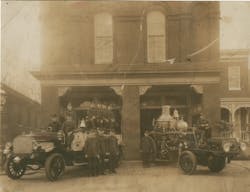Rekindles: July 2011
NORTH ASHBURHAM, MA: JULY 4, 1911 – Boys celebrating Independence Day were thought to have accidentally started a fire that burned the Old Congregational Church, five dwellings and several other buildings. The boys apparently climbed into the belfry of the 70-year-old church to ring the bell and dropped a match or a cigarette, igniting the blaze.
KINEO, ME: JULY 9, 1911 – A huge forest fire in the Frenchtown district was burning out of control and nearly trapped three firefighters as the walls of flame began to encircle them. Scores of rescuers moved in quickly and saved their comrades in the nick of time. The fire had already consumed more than 3,500 acres and was being fought by 250 firefighters.
CHICAGO, IL: JULY 10, 1911 – An early-morning fire destroyed the stables of the Dixon Transfer Co. and killed 263 horses. The four-story stable housed 350 draught horses (a heavy horse, like a Clydesdale, used for hauling) valued at $250 each (the buying power of $1 in 1911 had about the same value as $22 today) Firemen rescued nearly 100 horses before the roof and walls crashed into the basement. Scores of firemen narrowly escaped death during this collapse. The stables were five blocks from the downtown business quarter. Several hours later, firemen battled another huge blaze in a furniture warehouse not far from the first fire.
OSCODA, MI: JULY 11, 1911 – A forest fire closed in on Oscoda and the adjacent town of Au Sable, causing their 1,800 inhabitants to escape the flames in a large steamship and a special train made up of freight cars. As the people were hurried to safety, the fires descended and destroyed both towns. Several other towns were threatened and 40 cars and two bridges of the Michigan Central Railroad were also destroyed. A telegraph lineman made his way around the fire and climbed a pole four miles south of the flames to report conditions to authorities.
WEST ORANGE, NJ: JULY 10, 1911 – An explosion tore through a two-story frame building used by the Edison Co. to manufacture chlorine. Instantly, the building was engulfed in flames. There were no employees inside at the time and firemen protected the exposures and prevented further loss.
NEW YORK CITY: JULY 16, 1911 – After battling an all-night fire at 146 William St., the FDNY took up and returned to quarters. One fireman who was left behind as a watchman then discovered a separate blaze at 49 Ann St. just around the corner. These buildings, used as workshops, had a power plant in the basement and this was believed to have started the fire. Acting Chief Kenlon transmitted a second alarm as the fire communicated throughout the row of five-story frame buildings. Firemen struggled to locate a missing watchman, who turned up later after returning to the scene.
HARRISBURG, PA: JULY 16, 1911 – Flames destroyed a bakery, a residence and a warehouse during an apparent arson fire. The fire began in the Schmidt Bakery, said to be the largest in this part of the state. The blaze spread quickly, forcing the baker and his family, in their nightclothes, from their home adjacent to the bakery. The flames then ignited a nearby warehouse and destroyed 15 delivery wagons and an automobile.
MORRIS PLAINS, NJ: JULY 21, 1911 – A fire apparently ignited by lightning was discovered in the cupola of the State Mental Hospital. Immediately under the burning tower 1,200 patients resided in dormitories. The patients were quickly and quietly moved to the dining room while the medical director instructed the head chef to feed the patients. “Get dinner on and get it right away. The building is afire and you keep the patients eating until we get the fire out.” The tower was now a sheet of flames and firemen battled the stubborn smoky fire that dropped into the dorms below. After several hours, the fire was brought under control. The patients continued eating, unaware of the fire nearby.
WALLINGFORD, CT: JULY 21, 1911 – During morning Mass at Holy Trinity Catholic Church, a bolt of lightning struck the spire just below the gold cross and burned downward, igniting the 150-foot wooden steeple. The priest and congregants escaped as the fire began to fill the spire above. Wallingford firemen were on the scene quickly and a request for help was immediately sent to nearby Meriden. The mutual aid fire company was on scene in an amazing 11-minute response. But despite their combined efforts, the steeple collapsed through the church’s roof, injuring three firemen. The church, built in 1876, suffered $40,000 in damage.
ROSELLE, NJ: JULY 22, 1911 – The sounds of the fire alarm rang in the distance. Realizing that most of the volunteer firemen were out of town on an excursion, Mrs. Charles McQuad broke up a bridge party at her home and hurried her eight guests into her car. She drove to the fire station where several men had assembled, but not enough to pull the apparatus. She told the men to attach the rig to her car and she pulled it to the scene of a house fire on Fourth Avenue. She then directed the other women on various tasks to help the undermanned fire crew attack the flames. Hoses were stretched and the fire was quickly extinguished. The women, in smoke-stained dresses, returned to finish their game of bridge.
TOLEDO, OH: JULY 23, 1911 – Eight firemen were injured battling a morning fire at a company that manufactured billiard balls and pool tables. Four buildings and eight homes were lost as flames leapt from structure to structure. Firemen battled walls of flames and intense radiant heat generated by the frame buildings.
